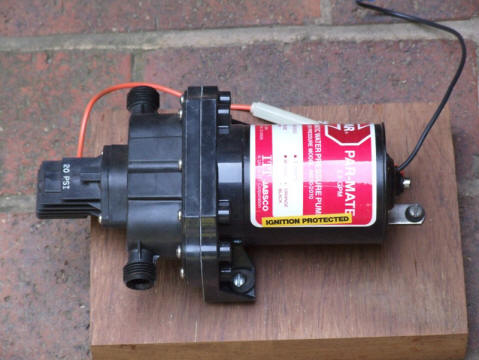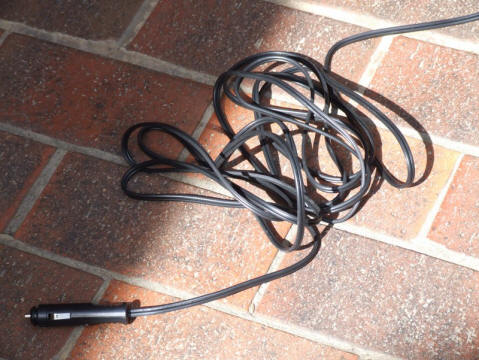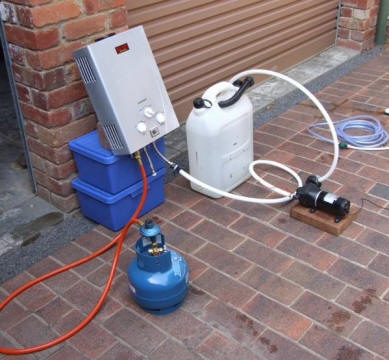|
custom
hot water system
for indoor or outdoor use

Initially I
purchased a Primus hot water unit to cater for our hot water needs,
however I found the Primus inefficient for what we required. It
needed to be operated by two people if the water flow was turned on
and off several times during the shower process. My idea was to have
a hot water system that could heat itself automatically when turned
on, turn itself off when the water flow was stopped, wouldn’t use
huge quantities of water and could be used out in remote camping
areas.
the heater unit
Having looked at similar setups this is what I eventually put
together. The main water heating unit was purchased on ebay . It is
called a Red Hot Water Heater which is all I can find as a
brand name. The unit is very similar to the Mercury instant hot
water unit with the main difference being a LCD display built into
the unit showing the water temperature. This I felt was a great
advantage over similar units as you can readily tell what the water
temperature is going through the unit.
The water heater automatically shuts off if the water
temperature reaches 77 degrees C. It also shuts down after 20
minutes continuous usage. However, it can be turned back on
immediately but I couldn’t imagine this being a problem. On my
initial run it took approx. 4 – 5 seconds for the water to go from
20 degrees C up to 44 degrees C which is more than enough to enjoy a
warm shower. The horizontal window above the winter/summer switch is
the viewing window for the gas light. It does not operate with a
pilot light but activates itself once the water flow commences
running through the unit. The unit weighs 2.5 kg.

I also purchased a regulator
and had a 2 metre gas hose made up to go onto a 2kg gas bottle. The
reason for the extra long gas hose is that the gas cylinder can be
some distance away from the shower tent and water heating unit.
the pump
The next item for the system was the pump. The pump is
perhaps the main piece of equipment in the system as it drives the
water through the unit and draws the water from a source.
I am using a Jabsco 12volt pump as my main pump mounted on a piece
of timber to provide some stability. I also have a spare pump should
anything unforseen occur to the Jabsco pump. I purchased an XTrail
pump which is also a 12volt automatic pressure pump which will
generate up to 40psi and more than capable of operating the hot
water unit.

Jabsco 12v automatic switch pressure
pump
The Jabsco Par-Mate is a 12v
automatic water pressure pump with the following features:
Self-priming
It can run dry without damage to the pump
Very quiet when operating
Smooth water flow
Low current draw – 4.2 amp
Small and lightweight – 1.5 kg
23.3cm x 13.3cm x 8.5cm
The pump will generate up to 36 psi pressure which is
sufficient for the hot water unit to operate. Both pumps are fitted
with water filters to eliminate any foreign objects from running
into the hot water unit.
12volt

I then purchased a 12v plug and cable to connect the pump to the
power source in the camper. The camper has several 12v outlets.
hosing
The next step was to acquire all the necessary
hosing and connections to suit both the pump and the hot water unit.

This hosing did the job
nicely and provided sufficient to use for connections and have
sufficient left over to use if pumping within 16 metres of a water
source (dam, river or lake etc). It is non collapsible reinforced
nylon hosing used in caravans and campers.

Next was to extend the
shower hose that came with the unit so that we could run the shower
hose under the shower tent from the hot water unit and up onto a
hook inside the shower tent.
Also I added to the hose a stop valve which enables the user
to stop the flow of water and subsequently turn off the unit. When
your ready to restart the hot water unit you simply turn the valve
back on within the shower tent and the unit automatically starts up
again. This is extremely convenient if your on your own.
The hot water unit has an automatic electronic ignition which
operates from two D cell batteries inside the unit. I’m told the
batteries should last up to 2 – 3 years with normal use.
final result

whole unit looks like this
|
hot water unit
|
$207 |
|
12v pressure pump
|
$82 |
|
hosing |
$54 |
|
hose clips |
$8 |
|
gas hose and regulator
|
$42 |
|
12v plug |
$7 |
|
water valve |
$3 |
|
shower hosing |
$12 |
|
total cost |
$415 |
thanks to Paul
McDougall for sharing this idea
april 2009
|